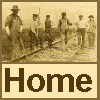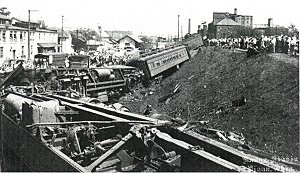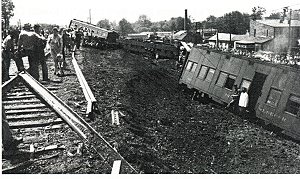 Railroads of Madison County
Railroads of Madison County6/5/2018
|
TROOP TRAIN DERAILS AT PIQUA, OHIO |
|
May 21,1945 By Scott D. Trostel
|
In recounting the events leading up to the derailment the train. the Pennsylvania Railroad line between Columbus and Bradford, Ohio, had been subjected to capacity volumes of war time traffic in the previous five years and maintenance had been minimal with a large number of men off to war. The railroad had resorted to using Mexican immigrant labor, hiring high school boys and women to work on section gangs. The track had been severely neglected. Ballast was fouled with mud and tie replacement programs had been all but abandoned.
 May 21st had been a sunny warm spring day, the track supervisor had been able to garner enough help to start a program of switch tie replacement and spot tamping in order to minimize the worst conditions. Gangs were working Sections 11 and
12 between Mile Post 66 at Fletcher and 74 at Piqua.
May 21st had been a sunny warm spring day, the track supervisor had been able to garner enough help to start a program of switch tie replacement and spot tamping in order to minimize the worst conditions. Gangs were working Sections 11 and
12 between Mile Post 66 at Fletcher and 74 at Piqua.
The first indication of anything suspicious was the troop trains' passage by a ballast gang at mile post 68 and the high speed of the train even though it was under a slow order and yellow flag. The surviving members of that section gang recall having to step back further off the right-of-way than normal because of speed. Soon the train had disappeared to the west down the hill toward Piqua.
A larger tie and ballast gang was working at Mile Post 73 in Piqua on the west end of the passenger platforms. They were cribbing the fouled ballast and replacing switch ties through a trailing point cross-over on the west bound track. From mile post 72 the tracks swing around a gentle one degree curve to the left while dropping down the ruling east bound Columbus Division grade of 0.7 percent on a high fill and finally reaching the Great Miami River. West of the river the railroad is on a fill constructed in 1913, eliminating street level crossing and two helper grades out of Piqua. It was just 0.25 miles to Mile Post 73, site of the incident.
The playground of a local school sat on the banks of the river just south of the bridge. The school's lunch hour was under way with the usual baseball games in progress when one fellow made a comment how fast the train seemed to be going as it passed o'er the river bridge. Momentarily there was a rumbling sound then silence. The kids played on unknowing of what had just happened.
Two fellows employed at a Morrow Transfer Service just west of Mile post 73 with a warehouse on the north side of the embankment looked up to see it was a troop train passing and started to wave at the soldiers as had been their habit. The locomotive and first six cars had zipped by when they realized things were suddenly terribly wrong. They described the derailment: "Then suddenly there was a rumbling noise and one car jumped into the air and the other began to wobble as they left the track. It seemed as though the cars would tumble down the embankment and come crashing into the Transfer company and machine shop buildings."
The train had just derailed at mile post 73.
 The section gang at the scene immediately went to the aid of the soldiers. Two cars had rolled over while coming down the embankment, stopping against the yard engine and its caboose, sitting at the water spout on the lower yard tracks. They were derailed by the impact.
The section gang at the scene immediately went to the aid of the soldiers. Two cars had rolled over while coming down the embankment, stopping against the yard engine and its caboose, sitting at the water spout on the lower yard tracks. They were derailed by the impact.
The accident had occurred on the Roosevelt Street overpass just a short block from the Piqua fire and police stations, aid was quick in coming. All local ambulance services were immediately summoned to the scene. Twenty four soldiers were removed from the overturned coaches to the local hospital tor treatment, most suffering broken legs, arms, wrists cuts, burses and shock. Medica1 personnel, doctors and nurses were summoned from all area communities fearing the toll and degree of injuries would be much higher. A medical corps was dispatched from Patterson Field in nearby Dayton, Ohio, (now Wright Patterson Air Force Base) to handle extended treatment of the more seriously injured.
Mary Tooley, head of the Junior Girls Canteen at Troy, 8 miles south, received an urgent call from the Piqua Y.M.C.A. asking for any help the Canteen Girls could give. The derailment was just two blocks west of the Y.M.C.A. facility. Calls immediately went out in Troy for all the volunteers. The girls and ladies all came. The workers were split into teams because many would be needed in Troy to continue meeting the B & O trains.
About 24 baskets of sandwiches, fruit and desserts were rapidly prepared for the men of Piqua plus additional for trains expected in Troy in less than two hours. As the girls were to discover when they arrived, most if not all of those men were flyers who had been shot down by the Germans and imprisoned. They set up their canteen at the Y.M.C.A.
 A brief article in the Troy paper tells the story of the Junior Girls Canteen efforts that Car. "Sandwiches, coffee, fruit and cookies and volunteers were loaded in automobiles and rushed to the Piqua Y.M.C.A. where the injured and others were taken. These were passed out and were received with pleasure by the battle-scarred veterans of the European conflict gathered there. Many complimentary remarks were heard for the service rendered and many of the boys themselves heaped praise for the thoughtfulness of the act in their behalf."
A brief article in the Troy paper tells the story of the Junior Girls Canteen efforts that Car. "Sandwiches, coffee, fruit and cookies and volunteers were loaded in automobiles and rushed to the Piqua Y.M.C.A. where the injured and others were taken. These were passed out and were received with pleasure by the battle-scarred veterans of the European conflict gathered there. Many complimentary remarks were heard for the service rendered and many of the boys themselves heaped praise for the thoughtfulness of the act in their behalf."
Because of the war time urgency the area was immediately' sealed off. The official Pennsylvania Railroad photographer, Raymond T. Lange, himself a civilian employee at Patterson Field had taken a day's vacation and was at home when he heard the sounds of a derailment. As was his habit, he grabbed his press camera and several film clips and started for the wreck site. Ono this day his wife Marie went along to help with supplies. Even though he had authority to be on the property he was refused admission for reasons of national security. Raymond, or "Step" as he was known, noticed several of the soldiers acting as guards were thirsty and unable to leave their posts to get refreshment at a local grocery. Step and his wife departed the area and purchased several cases of ice cold Coke Cola and arriving back at the security post offered to give refreshment to the soldiers. In doing so they were permitted to enter the secured area to distribute the drinks and to photograph the derailment. Step made two exposures of each view, sending one set of negatives and prints to the Pennsylvania Railroad while the other set of negatives was filed away and forgotten since this derailment had become a matter of national security for a time and all records were sealed. The views in this article are from his negatives
 The Red Cross Canteen Corps arrived at the scene offering coffee, milk and soft drinks to the soldiers, most of whom had by this time become involved in the salvaging of their personal possessions. Those uninjured were offered temporary shelter at the local YMCA, just two block from the derailment scene. There they could get showers, swim and relax. The troops on the six underailed cars continued their journey after about two hours of delay. The rest of the troops awaited the arrival of a relief train at 6:45 p.m. that evening. Their destination were Camp Atterbury, Indiana, Jefferson Barracks, Missouri, and Fort Bliss, Texas. Ironically, most of the troops on this train had been wounded in combat and wore purple hearts. One soldier, Pvt. Charles Taylor had suffered head wounds in Germany and sat quietly holding a broken wrist at the hospital. Many of the men served in the 8th Air Force Airborne and were involved in the saturation bombing of Germany. Many of that number were returning from captivity as prisoners of Germany. Three of the Pullman Porters were also injured in the derailment.
The Red Cross Canteen Corps arrived at the scene offering coffee, milk and soft drinks to the soldiers, most of whom had by this time become involved in the salvaging of their personal possessions. Those uninjured were offered temporary shelter at the local YMCA, just two block from the derailment scene. There they could get showers, swim and relax. The troops on the six underailed cars continued their journey after about two hours of delay. The rest of the troops awaited the arrival of a relief train at 6:45 p.m. that evening. Their destination were Camp Atterbury, Indiana, Jefferson Barracks, Missouri, and Fort Bliss, Texas. Ironically, most of the troops on this train had been wounded in combat and wore purple hearts. One soldier, Pvt. Charles Taylor had suffered head wounds in Germany and sat quietly holding a broken wrist at the hospital. Many of the men served in the 8th Air Force Airborne and were involved in the saturation bombing of Germany. Many of that number were returning from captivity as prisoners of Germany. Three of the Pullman Porters were also injured in the derailment.
By 9:45 p.m. the main track was reopened to west bound traffic. After the section hands helped to get the soldiers out of the cars they walked back up the embankment, picked up their tools and began to work on damaged track. They had restored most of the damaged track by the time the first wrecking derrick from Richmond, Indiana, arrived. The cars were moved off of the embankment and they were given enough attention to get them into Columbus for maintenance on May 24. The officially stated cause of the derailment was listed as a broken rail. It was, however. determined that the train had been operating at speeds in excess of condition for the track and had lifted itself from the track in areas where no ballast existed.
Two days after the wreck, a small notice appeared in the Miami Union that one of the injured men, T/Sgt Jerrell H. Adamson of Oklahoma, had died at the Patterson Field Hospital as a result of injuries sustained in wreck. He had successfully flown 35 mission over Europe and was on his way home.
|
The injured included: T/Sgt Jerrell H. Adamson, Edmond, Oklahoma died as a result of injuries.
Pvt. Arthur W. Jahns, Fremont, Ohio
PULLMAN COMPANY EMPLOYEES
|

Contact:
MCHGS
PO Box 808
Piqua, Ohio 45356-0808
Picture Credits:
Photos by Raymond T. Lange
Return to Top of Page or Return to Main Page

Date June 5, 2018.
This "Railroads of Madision County" page is written, maintained and hosted by: Roger P. Hensley madisonrails@railfan.net
Copyright 2018 by Roger P. Hensley.